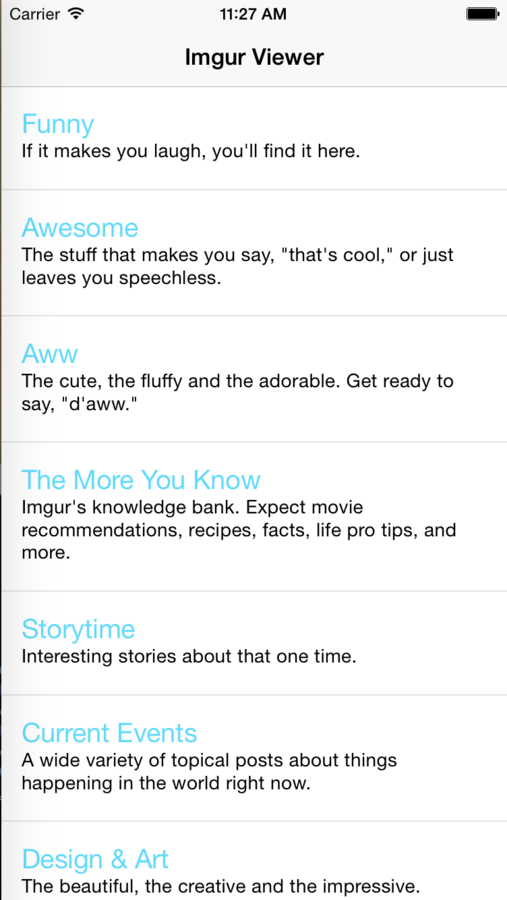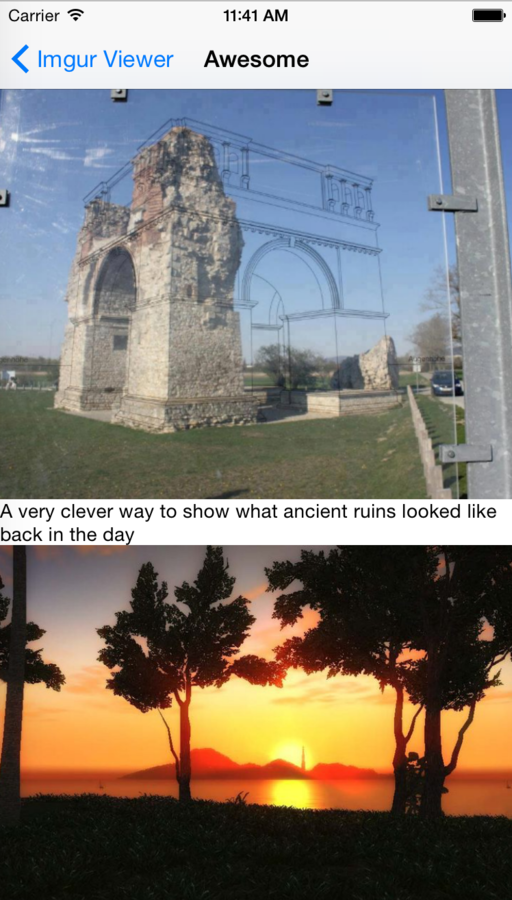Hacking React Native
Building a Native IOS Imgur Browser in JavaScript

Getting Started
- cd to working directory
- react-native init myApp
- cd myApp
- open myApp.xcodeproj

Project Setup
- npm install react-native-device --save
- create app folder in root directory
- create data folder in app directory
- create the following files in app directory:
- entry.js
- drilldown.js
- data/api.js

Project Setup
- visit https://api.imgur.com/
- sign up
- copy client_id , or have client_id available for reference

IMGUR Api
Open index.ios.js

Add NavigatorIOS to React destructuring statement.
var {
AppRegistry,
StyleSheet,
Text,
View,
NavigatorIOS
} = React;In index.ios.js

return (
<NavigatorIOS
style={{flex:1}}
ref="nav"
initialRoute={{
component: entry,
title: 'Imgur Viewer'
}} />
);Replace existing render code with the following:
Require entry component below React require statement.
var entry = require('./app/entry');Open entry.js

Copy or type code below into entry.js
var React = require('react-native');
var {
StyleSheet,
Text,
View,
TouchableHighlight,
NavigatorIOS,
ScrollView
} = React;
var ImgurViewer = React.createClass({
render: function() {
return(
<View>
<Text
style={{marginTop:66}}>
Hello From ENTRY Component
</Text>
</View>
)
}
});
module.exports = ImgurViewerRefresh IOS Simulator

You should see the following:

Open data/api.js

var rootUrl = 'https://api.imgur.com/3/';
var apiKey = '7eb03b39c91e55f';
module.exports = {
get: function(url) {
return fetch(rootUrl + url, {
headers: {
'Authorization': 'Client-ID ' + apiKey
}
})
.then(function(response) {
return response.json()
})
}
};Copy or type code below into api.js
Replace apiKey with your client id
Open entry.js

var React = require('react-native');
var API = require('./data/api');
var Device = require('react-native-device');
Update required modules / components:
In entry.js

getInitialState: function() {
return {
topics: []
}
},
componentWillMount: function() {
API.get('topics/defaults')
.then(function(data) {
this.setState({
topics: data.data
})
}.bind(this))
},Add the following in the React Class, before render function:
In entry.js

console.log(this.state.topics)
var self = this;
var topics = this.state.topics.map(function(topic, key) {
return (
<View>
<TouchableHighlight onPress={console.log(topic.id)} underlayColor="#f1f1f1" style={[styles.drilldown, {width:Device.width}]}>
<View>
<Text style={{fontSize:20, color: '#0098e6'}}>{topic.name}</Text>
<Text>{topic.description}</Text>
</View>
</TouchableHighlight>
</View>
)
})
return (
<View style={[styles.container]}>
<ScrollView>
{topics}
</ScrollView>
</View>
);Update render function to the following:
In entry.js

var styles = StyleSheet.create({
container: {
alignItems: 'center',
flex: 1,
justifyContent: 'center',
},
welcome: {
fontSize: 20,
textAlign: 'center',
margin: 10,
},
instructions: {
textAlign: 'center',
color: '#333333',
marginBottom: 5,
},
drilldown: {
padding:15,
paddingBottom:20,
borderBottomWidth:1,
borderBottomColor: '#e3e3e3'
}
});Add the following object before module.exports:
Refresh IOS-Simulator

You should see the following:

Open drilldown.js

var API = require('./data/api');
var Device = require('react-native-device');
var React = require('react-native');
var {
StyleSheet,
Text,
View,
TouchableHighlight,
NavigatorIOS,
ScrollView,
Image
} = React;
var DrillDown = React.createClass({
render: function() {
return(
<View><Text style={{marginTop:66}}>HELLO FROM DRILLDOWN</Text></View>
)
}
});
module.exports = DrillDown;Copy or type code below into drilldown.js
Open entry.js

var DrillDown = require('./drilldown');Add drilldown component to entry.js
Create function to navigate to drilldown:
_getTopicFromId: function(topicName, topicId) {
this.props.navigator.push({
component: DrillDown,
title: topicName,
passProps: {
id: topicId
}
});
},Add click handler to TouchableHighlight:
onPress={self._getTopicFromId.bind(this, topic.name, topic.id)} Refresh IOS-Simulator

Click on topic, then you should see the following screen:

Open drilldown.js

Add the following functions in DrillDown class, before render function:
getInitialState: function() {
return {
images: []
}
},
componentWillMount: function() {
API.get('topics/' + this.props.id)
.then(function(json) {
this.setState({
images: json.data
})
}.bind(this))
},
getImageUrl: function(id) {
var link = 'http://i.imgur.com/' + id + 'h.jpg';
return link
},In drilldown.js

Update render function to the following:
var self = this;
var content = this.state.images.map(function(image) {
return (
<View key={image.id} style={{borderBottomColor: '#0098e6', borderBottomWidth:3}}>
<Text style={{padding:20,fontSize:16, color: '#494949'}}>{image.title}</Text>
<View >
<Image
source={{uri: self.getImageUrl(image.id)}}
style={{width:Device.width, height:300}} />
</View>
</View>
)
});
return(
<ScrollView >
{content}
</ScrollView>
)Refresh IOS-Simulator

Click on a topic, you should see the following:

Thank you!

Follow me @dabit3
Nader Dabit
ABOUT ME:
Developer at School Status
Follow SchoolStatus @schoolstatusapp
Download completed app HERE
dabit3@gmail.com